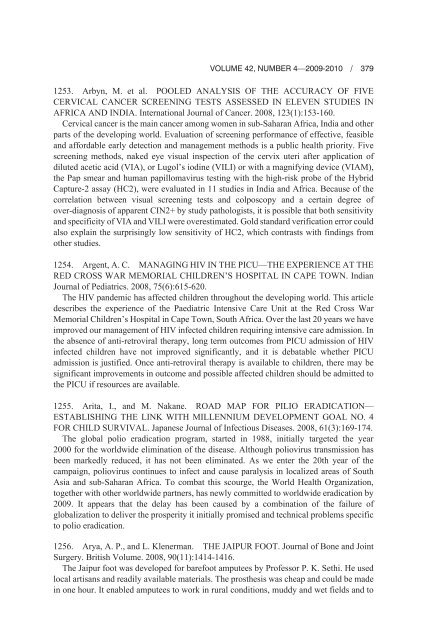A Current Bibliography on African Affairs - Baywood Publishing
A Current Bibliography on African Affairs - Baywood Publishing
A Current Bibliography on African Affairs - Baywood Publishing
You also want an ePaper? Increase the reach of your titles
YUMPU automatically turns print PDFs into web optimized ePapers that Google loves.
VOLUME 42, NUMBER 4—2009-2010 / 379<br />
1253. Arbyn, M. et al. POOLED ANALYSIS OF THE ACCURACY OF FIVE<br />
CERVICAL CANCER SCREENING TESTS ASSESSED IN ELEVEN STUDIES IN<br />
AFRICA AND INDIA. Internati<strong>on</strong>al Journal of Cancer. 2008, 123(1):153-160.<br />
Cervical cancer is the main cancer am<strong>on</strong>g women in sub-Saharan Africa, India and other<br />
parts of the developing world. Evaluati<strong>on</strong> of screening performance of effective, feasible<br />
and affordable early detecti<strong>on</strong> and management methods is a public health priority. Five<br />
screening methods, naked eye visual inspecti<strong>on</strong> of the cervix uteri after applicati<strong>on</strong> of<br />
diluted acetic acid (VIA), or Lugol’s iodine (VILI) or with a magnifying device (VIAM),<br />
the Pap smear and human papillomavirus testing with the high-risk probe of the Hybrid<br />
Capture-2 assay (HC2), were evaluated in 11 studies in India and Africa. Because of the<br />
correlati<strong>on</strong> between visual screening tests and colposcopy and a certain degree of<br />
over-diagnosis of apparent CIN2+ by study pathologists, it is possible that both sensitivity<br />
and specificity of VIA and VILI were overestimated. Gold standard verificati<strong>on</strong> error could<br />
also explain the surprisingly low sensitivity of HC2, which c<strong>on</strong>trasts with findings from<br />
other studies.<br />
1254. Argent, A. C. MANAGING HIV IN THE PICU—THE EXPERIENCE AT THE<br />
RED CROSS WAR MEMORIAL CHILDREN’S HOSPITAL IN CAPE TOWN. Indian<br />
Journal of Pediatrics. 2008, 75(6):615-620.<br />
The HIV pandemic has affected children throughout the developing world. This article<br />
describes the experience of the Paediatric Intensive Care Unit at the Red Cross War<br />
Memorial Children’s Hospital in Cape Town, South Africa. Over the last 20 years we have<br />
improved our management of HIV infected children requiring intensive care admissi<strong>on</strong>. In<br />
the absence of anti-retroviral therapy, l<strong>on</strong>g term outcomes from PICU admissi<strong>on</strong> of HIV<br />
infected children have not improved significantly, and it is debatable whether PICU<br />
admissi<strong>on</strong> is justified. Once anti-retroviral therapy is available to children, there may be<br />
significant improvements in outcome and possible affected children should be admitted to<br />
the PICU if resources are available.<br />
1255. Arita, I., and M. Nakane. ROAD MAP FOR PILIO ERADICATION—<br />
ESTABLISHING THE LINK WITH MILLENNIUM DEVELOPMENT GOAL NO. 4<br />
FOR CHILD SURVIVAL. Japanese Journal of Infectious Diseases. 2008, 61(3):169-174.<br />
The global polio eradicati<strong>on</strong> program, started in 1988, initially targeted the year<br />
2000 for the worldwide eliminati<strong>on</strong> of the disease. Although poliovirus transmissi<strong>on</strong> has<br />
been markedly reduced, it has not been eliminated. As we enter the 20th year of the<br />
campaign, poliovirus c<strong>on</strong>tinues to infect and cause paralysis in localized areas of South<br />
Asia and sub-Saharan Africa. To combat this scourge, the World Health Organizati<strong>on</strong>,<br />
together with other worldwide partners, has newly committed to worldwide eradicati<strong>on</strong> by<br />
2009. It appears that the delay has been caused by a combinati<strong>on</strong> of the failure of<br />
globalizati<strong>on</strong> to deliver the prosperity it initially promised and technical problems specific<br />
to polio eradicati<strong>on</strong>.<br />
1256. Arya, A. P., and L. Klenerman. THE JAIPUR FOOT. Journal of B<strong>on</strong>e and Joint<br />
Surgery. British Volume. 2008, 90(11):1414-1416.<br />
The Jaipur foot was developed for barefoot amputees by Professor P. K. Sethi. He used<br />
local artisans and readily available materials. The prosthesis was cheap and could be made<br />
in <strong>on</strong>e hour. It enabled amputees to work in rural c<strong>on</strong>diti<strong>on</strong>s, muddy and wet fields and to




